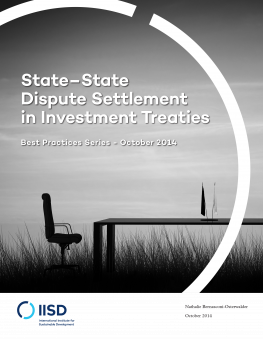
IISD Best Practices Series: State-State Dispute Settlement Clause in Investment Treaties
This paper looks at state–state dispute settlement provisions in international investment agreements, examining the different mechanisms used to settle investment disputes, including judicial, quasi-judicial and arbitration procedures.
Investor–state arbitration has boomed over the past decade, with the number of recorded cases having risen from 51 in 2000 to 568 by the end of 2013.
At the same time, state–state arbitration has taken a backstage role—only four such cases have occurred under investment treaties. Despite their rarity, state–state dispute settlement options are gaining renewed attention, given the growing concerns over the nature of investor–state arbitration claims (which often include challenges to legitimate environmental and other public welfare and financial policy measures), the high costs of arbitration, and the perceived lack of openness, independence and predictability.
Key questions today are: as investor–state arbitration is increasingly put into question, should investment dispute settlement be conducted solely on a state–state basis? Or, if both state–state and investor–state arbitration are included in the treaty, what areas should be subject to either mechanism exclusively, and what areas to both? Finally, if both are included, how should the two mechanisms interrelate?
This paper looks at state–state dispute settlement provisions in international investment agreements. It examines the different mechanisms used to settle investment disputes, including judicial, quasi-judicial and arbitration procedures. It then looks at the different types of claims that can be brought under the typical state–state clause, which include diplomatic protection claims, interpretive claims and declaratory relief requests. The paper also analyzes how treaty and case law deal with the interaction of state–state and investor–state dispute settlement where the treaty provides for both. It concludes with recommendations on how state–state dispute settlement could be used as an alternative to investor-state arbitration, or, if both mechanisms are included, on how to define the relationship between the two and to strengthen the state parties’ control over the interpretation of their treaty.
In particular, the paper recommends evaluating the risks and benefits of state–state dispute settlement as the sole mechanism or as additional to investor–state dispute settlement. States should clarify whether they wish to require exhaustion of local remedies and other customary international law requirements before a state–state claim can be initiated. It would also be useful to weigh the pros and cons of ad hoc third-party adjudication in comparison to a more permanent, judicial or quasi-judicial mechanism, as well as to clarify the meaning of “dispute concerning the interpretation or application of the treaty” or allowing for (advisory) opinions. Finally, states could clarify whether and in which situations the state–state decision should be binding for subsequent state–state or investor–state tribunals; they could also clarify how parallel state–state and investor–state cases might be coordinated, for example, if one had to be suspended in certain circumstances.
You might also be interested in
IISD Best Practices Series: The Most-Favoured-Nation Clause in Investment Treaties
This IISD Best Practices paper studies the most-favoured-nation (MFN) clause in investment treaties and its interpretation by arbitral tribunals, drawing lessons for states.
IISD Best Practices Series: Exhaustion of Local Remedies in International Investment Law
Part of IISD’s Best Practices Series, this advisory bulletin reviews state-of-the-art options and approaches to the exhaustion of local remedies requirement in international investment law.
IISD Best Practices Series: Performance Requirements in Investment Treaties
This paper surveys the types of performance requirements (PRs) in use around the world, and briefly describes the WTO’s Agreement on Trade-Related Investment Measures (TRIMs).
IISD Best Practices: Compensation for Expropriation
This paper analyzes the principles governing compensation for expropriation, as well as the primary methods of calculating the amount.